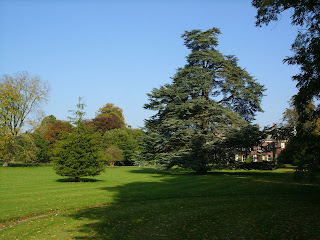A Day Out at Kew Gardens, with Barron's Tree transporter
 |
| Our mighty Cedar of Lebanon, centre of the lawn, Betley Court |
After a few hours’ internet research, I discovered that one
of these machines still existed – the last one in the world! And it was in the
collection of no less an institution than the Royal Botanical Garden at Kew.
Kat Harrington, an archivist at the Herbarium, put me in touch with Tony Hall,
manager of the arboretum and gardens, who in turn put me in touch with Kevin
Martin the Arboricultural Manager.
That’s how Nigel & I came to be on a train down to
London last week, on our way to meet Kevin and see Barron’s Tree Transporter.
In retrospect, we should’ve asked Kevin to wear a carnation in his lapel when
we arranged to meet outside the Orangery restaurant. Nigel approached several
strangers asking them, ‘are you Kevin?’ only to be met with confused stares,
although one guy replied with a twinkle in his eye, ‘oh, but I wish that I
was!’
We located Kevin eventually, and I’m glad we had him as our
guide. We would never have found our way to the arboricultural workshops
otherwise. And anyway, as our quarry, Barron’s Tree Transporter is not in the
public collection, we had effectively been granted a private viewing. Kevin
took us to an unprepossessing modern workshop building, located behind Kew’s
vast steaming compost heaps (I got gardener’s envy, I can tell you). Hidden
inside, at the back, there it was, a huge oak, cart-like machine, probably 7
feet high with wooden-spoked wheels with iron rims. Kevin explained that once
the tree transporter had been retired from active service at Kew, it had been
used as a prop outside the restaurant. Then it had languished in an open-sided
barn, suffering extensive rotting on one side, until Tony Kirkham, Head of the
Arboretum, recognising its historical importance, raised funds to restore it to
working order.
The restoration was a big undertaking. Only one wheel could
be salvaged, and tradesmen where commissioned to remake much of the cart. The
sophisticated metal steering assembly was cleaned and greased back to life.
 |
| page from my journal on the day |
A machine like this one had once moved our majestic Cedar of
Lebanon to its present spot, and what a clever bit of engineering it is. The
oak wheels are soaked before use ensuring a tight fit with the iron rims. If
you look at it unloaded, the wheels splay out at a funny angle. This makes sense
when you understand that Barron’s design allowed for not only the weight of a
mature tree, but the huge amount of root ball and soil required to ensure the
tree did not die when moved. Once loaded, the wheels ease into an upright
position. Barron knew that trees suffered less stress when transported upright,
and the cart’s design allows for parts to be uncoupled, reassembled around the
tree, then jacked up and secured onto the wheels.
Trees like our cedar were selected, then trundled to their new
home, upright, the safest way to avoid stressing the tree. The Tree Transporter was then used in reverse to lower the tree into a pre-prepared hole, keeping stress to a minimum. The relocation of trees must have been quite a sight, as trees are known to have
been moved up to 20 kilometres. to their new homes. I’m left wondering where Barron acquired Betley
Court’s cedar from? Were Betley villagers treated to the curiosity of a large
tree passing their cottages at a carthorse’s pace in 1866? That must've been quite a sight!
 |
| Barron's Tree Transporter |
 |
| Winching equipment |
 |
| Kevin demonstrating how it worked |




Comments
Post a Comment